This was published 3 years ago
Wessel Islands, Northern Territory travel guide: A spectacular, forgotten part of Australia
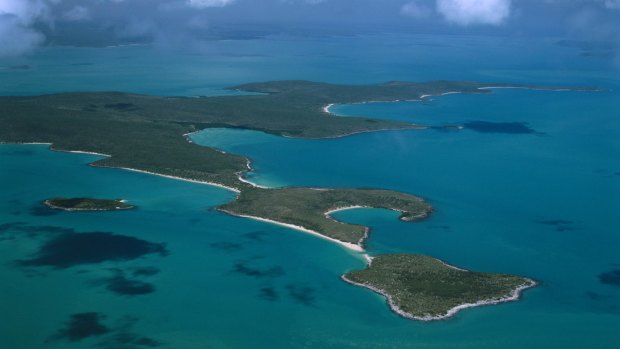
The Wessel Islands, a rugged, ribbon-like archipelago off the north-east tip of East Arnhem Land. Credit: Alamy
Airports in East Arnhem Land come without security screening (except Gove) and fat chance of a latte. They're little more than corrugated red mud tracks etched out between trees, barely wide enough for a plane to land. Rivers, creeks and estuaries run wild round here when the rains arrive with summer. You won't get in by road; the only way in or out is by air.
The coast, the estuaries and East Arnhem Land's savannah woodlands swarm with salt-water crocs bigger than the tinnies everyone gets about in. This chunk of the Northern Territory is almost the size of England, though its population's just shy of 20,000 (compare that to the latter's 56 million).
All but a few thousand (miners mostly, making a living digging bauxite out of the Gove Peninsula at Nhulunbuy) are Yolngu people living on their homelands, as they've done for 60,000 years, part of the oldest continuous civilisation left on Earth.
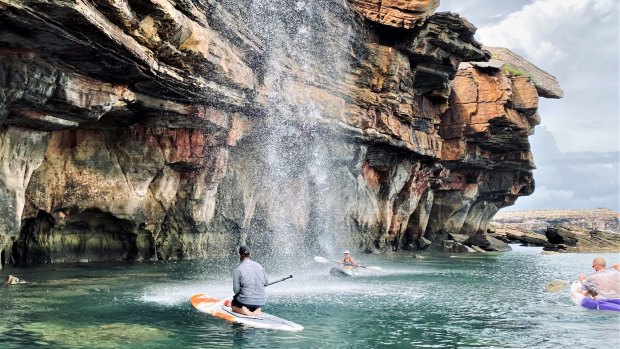
Guests can take kayaks and SUPs beneath waterfalls and beside intricate sandstone cliffs. Credit: Crooked Compass
It's wild at this north-east edge of the Territory. There's something about Arnhem Land that makes you feel like you're teetering on the edge of an abyss: one wrong step, and you're a goner. If you think it takes an African safari to truly experience the wild, try surviving a day up here in the bush by yourself.
And yet there are places in East Arnhem Land wilder still. These are destinations that even tough Territorians know nothing about. There are about 500 islands off this northern coastline, scattered across the empty space between where the Territory ends, and Indonesia begins.
And nowhere's wilder than the Wessel Islands, a rugged, ribbon-like archipelago off the north-east tip of East Arnhem Land. No-one lives here – though the Yolngu people made it their home for thousands of years. Few ever visit. But one boat will get you there; in the heart of summer, as the monsoons turn the Wessels' rocky east coast into one endless waterfall. Crooked Compass run six-day tours with a maximum of eight guests on board a fishing charter vessel that'll get you to the most secretive parts of these secret islands. In these pandemic times, could there be anything more decadent, or even therapeutic, than all this wilderness, shared with just a handful of other guests?
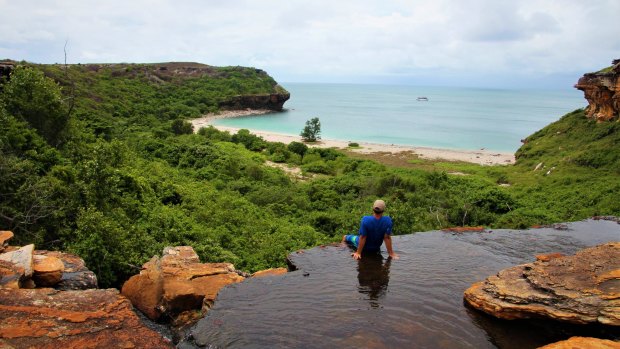
Climbing to the top of waterfalls offers great views.Credit: Crooked Compass
THE FORGOTTEN ISLES
"We were keeping this a secret," M/Y Wildcard skipper Bruce Davey says. He's in his pyjamas, believe it or not. They're pink, incidentally, with blue butterflies (odd for a Territorian). He's wearing them even as he feeds the anchor chain out on the front deck. It's still early, mind you. Barely light enough to see last night's rain pouring off the cliffs in a bay we've steamed half the night to reach.
"Geez, you just think: f-- all people have seen this place," he says. "If this was in NSW there'd be a Sheraton here, a Hilton there, a McDonald's beside that beach."
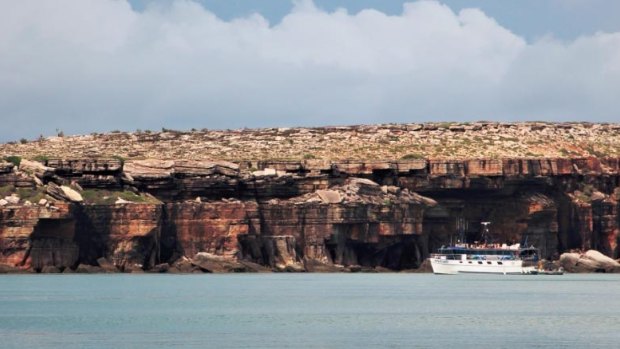
The MY Wildcard is dwarfed by the high cliffs of the Wessel Islands' rugged east coast.Credit: Crooked Compass
Davey squints - like he's imagining a mini-Sydney Harbour out of this place - but there's not a single building, nor another boat. "I haven't lived in a house for 47 years. Who needs one when you got that for a backyard?"
The Wessel Islands archipelago runs north for 120 kilometres from the Gove Peninsula. First charted by the Dutch in the early 17th Century, it'd take two more centuries before the English discovered them. That honour belonged to a young Matthew Flinders, who sailed through here in 1803, referring to local Yolngu people as "Australians". It was the first time the term was recorded.
Smallpox – carried by Macassan traders (from Sulawesi in Indonesia) collecting kapung (sea cucumbers) – devastated the Yolngu people in the Wessels. By the 1960s, they'd left these islands altogether for settlements on the mainland. All that remains are their memories.
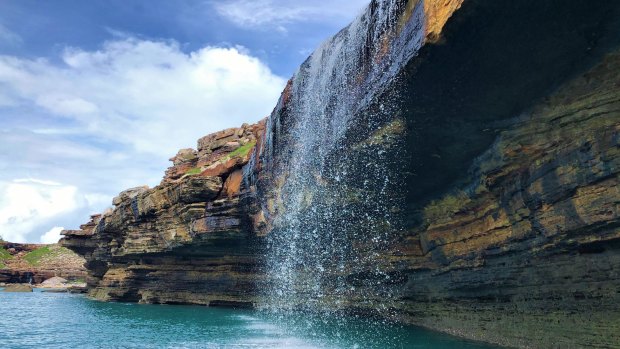
Millions of years of water flowing through has left Picture Bay looking like it was carved out by some secret civilisation.Credit: Crooked Compass
For most of the year, easterly trade winds and swells batter this east coast; but summer's another story entirely. Dominant westerly winds leave this side of the Wessels becalmed, and months of rain turn the coastline into one near-continuous waterfall.
THE CRUELEST SEA
Territorians fear their ocean. They're scared to swim in it, unsure what's within and rightly so since the sea up here is home to giant crocs, sharks and irukandji jellyfish. But the water on my tender ride to shore looks so transparent I see bait fish hide out between corridors of colourful coral, as we dodge waterfalls spilling straight into the sea.
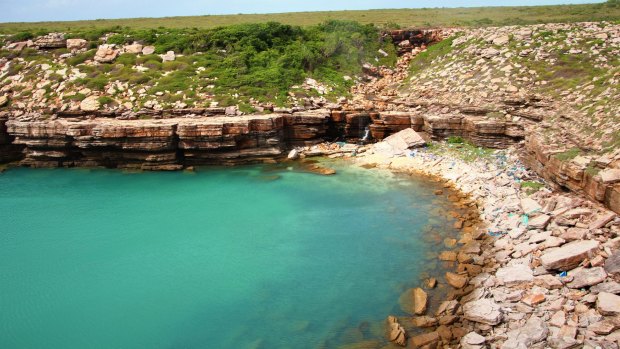
Only three bays in the Wessels have official names.Credit: Crooked Compass
With white sandy cays appearing out of nowhere at low tide, it looks more Maldives than murderous. When we land on a wide, white sandy beach, I jump in, though I don't stray far from the shallows. "Don't worry, you see 'em (crocs) from miles away," Davey says casually from the shore. "They've got these distinct orange eyes that glow."
Up on top of the cliffs – past the rock wallabies that cling to these slopes like mountain goats - there's infinity-edged rock pools with less chance of attack by any predator bigger than a yabbie. I loll in the shallows where the water eddies, picking up the pace it needs to spill over the edge.
This must have been a paradise for the Yolngu in these few bountiful months of summer. The sea teems with fish, and turtles and dugong (sea cow) – like juicy hamburgers for the Indigenous who roamed across these islands, living nomadically. I hike the higher plains here where the tall sea cliffs end.
A sudden downpour has me sheltering under a low rock shelf. I notice drawings etched in ochre on the roof of my shelter. I can make out a turtle, and a fish. "Bugger me, I've never seen these before," Bruce's wife, Juanita, matriarch of the ship, tells me. "You're probably the first person in 60 years to see this. Every time I come here, I find something I haven't seen before."
On the way back to the tender, I walk along a wide, flat rock platform above the ocean. Below – just round the corner from the beach I swam at – a two-metre-long croc swims by, using his stubby legs to push off the rock wall. Seconds later, a two-metre-long shark darts by. "Pig-eyed shark," Juanita explains. "Nasty little bugger."
Hours later, at a bay north from here, Bruce and I take a tender to troll for fish on dusk, and see drag marks on a beach beside us. "A croc must've taken something big up the beach there, a turtle, I reckon," he says. "Pays to keep your eyes open. Might look like the Maldives, mate, but there's a lot more things in the water that'll get you here."
A NAMELESS WORLD
In the morning, we up anchor and move to a bay that's all waterfall. Bruce calls this one "Picture Bay". Only three bays in the Wessels have official names, the other names exist only on the charts of the M/Y Wildcard.
I take a kayak beneath 80-metre-high cliffs, where water cascading over a million summers has carved intricate patterns into the sandstone. It looks like a secret civilisation built castles in the cliff face. Just round the corner, I hike through thick rainforest and find rock art beside a waterhole hidden in the bush.
Bruce has disappeared, he's got a mud map someone drew him that leads to a hidden cave full of art and skeletons. He's spent almost 40 years looking for treasure on these islands, like the almost 1000-year-old coins from an ancient Tanzania Sultanate. These are the oldest foreign artefacts ever found on Australian soil (a coin was first found by a soldier stationed here during World War II).
However it's the wreck of the Patricia Cam that's been a bigger obsession. The only Australian naval ship ever sunk in local waters, it was bombed by a Japanese float plane in 1943. One of the passengers was taken by the pilots and executed later in Indonesia, the only Australian taken as a prisoner of war on Australian soil. None of its wreckage has ever been found.
"You could spend a lifetime finding art and skulls and bits of boat round here," Bruce says later, when we meet back on board (he didn't find the cave). "I've found World War II planes, old mission houses and radar stations no-one knew about. I could spend the rest of my life exploring."
There are tales, too, of vast cave networks hidden by tidal lagoons, reachable only to those with the nerve to swim through flooded chambers in the dark to find ancient art galleries within. There's no Wi-Fi or phone signal anywhere along these islands, so there's plenty of time for stories.
While days end with canapes and sundowners on the top deck, the Wildcard is a functioning fishing boat with a crew. If you're expecting silver service, try another boat. And don't even think about wearing shoes to dinner.
What you'll get instead is an insight into the Territory no-one else gets: family time with a fifth-generation fishing clan who know these secret islands better than any non-Indigenous person on Earth. When they're not here, they're fishing Spanish Mackerel from the Gulf of Carpentaria, one of few fishing boats with a licence to do so.
Bruce is chief story-teller, the master of the craft. He has tales that will make your blood run cold, like the time a salt-water croc bit him on the head while he was diving for crayfish. "I thought Mike Tyson king-hit me," he says. "The croc was falling off me head, spitting and hissing".
But he's soon passing on the skipper's hat to son, Tiger. Tiger's Tiger because he happened to be born during his parents' best ever (tiger) prawn season. Meals are fixed by Tiger's wife, Prue, mum to little Ellica Bec, who may become the sixth generation of Davey fisher folk.
Friends Tom and fiancée Jess round out the cast of this reality TV show waiting to be commissioned. Mother Juanita is an ultra-marathon tragic, she has an exercise bike she thrashes like she's racing ghosts up on the top deck. Each day she forges a trail in the wilderness beside the coast, with a walkie talkie to call in when she needs a pick-up. "You see the odd croc on the beach," she tells me. "They get more of a fright than me."
NO NEWS IS GOOD NEWS
It's best spending the hottest part of the day over long lunches in the air conditioned part of the boat. But sea breezes keep temperatures far more bearable than you'd expect in the middle of a Territory summer (and it's nearly as rainy as you'd think either).
Cyclones don't tend to spin their way this far west from the Gulf (of Carpentaria) too often. I usually spend the last hours of each afternoon fishing for dinner. The sea's never static, something's always jumping, and biting; it's whether or not you've got the moves – and the muscle – to pull it in.
I find Nirvana around Day Five. Not through any activity such as hiking, beachcombing, swimming, fishing. No, it's but because it's when I realise I have no idea what day it is. There's something in my inability to determine Friday from Saturday (or Sunday?) that summons a sudden indifference to the news I'm missing.
The nagging feeling my state (Queensland) mightn't let me back in, evaporates. The only bulletins I receive come from Bruce and Tiger's weather forecasts, relayed to me each morning over breakfast. The out-take is there's no cyclones in sight: and what could be better news than that?
When we steam back to Nhulunbuy, my phone will knock itself out telling me all the news I missed. But for now, everything I need to care about is right here in this boat with me.
REMOTE CHANCES: FIVE MORE THINGS TO DO AND SEE IN EAST ARNHEM LAND
GARMA FESTIVAL
Join 2000 others in a four-day celebration of Yolngu culture in Gukula – an hour's light plane flight from Darwin. There's music, dance, art and story telling in Australia's largest Indigenous cultural exchange festival held each August, organised by the Yothu Yindi Foundation. See yyf.com.au
FISH FOR BARRA
East Arnhem Land is one of the best places on Earth to fish for wild barramundi in billabongs, floodplains and tidal rivers. While the sea off Arnhem Land is full of the tastiest species (like golden snapper) it's the fly fishing for barra that attracts anglers from all over the world to the many fishing lodges and charter boats. See northernterritory.com
BUKU-LARRNGGAY ART CENTRE
Check out one of the country's best Indigenous art complexes, 15 minutes outside Nhulunbuy in the Aboriginal community of Yirrkala. You'll find Aboriginal bark paintings, carvings and artefacts, as well as a museum, screen printing workshop and theatre. See yirrkala.com
DAVIDSON'S ARNHEMLAND SAFARIS
Sleep in safari huts in the bush after flying in by Cessna, then explore 700 square kilometres of exclusively leased wilderness where Indigenous peoples have lived for more than 50 000 years. Find some of Australia's best rock art amongst surrounding billabongs, monsoonal rainforest and wetlands. See arnhemland-safaris.com
GARIG GUNAK NATIONAL PARK
Fly an hour east of Darwin by light plane to the Cobourg Peninsula to hike and bird watch along the beaches and coastal dunes of Garig Gunak National Park. Visit Black Point Culture Centre, and discover six species of turtle and dugong and explore the offshore coral reefs. The park's also famous for fishing. See nt.gov.au
KNOW BEFORE YOU GO: FIVE THINGS TO CONSIDER WHEN VISITING ARNHEM LAND
GET A PERMIT
You'll need a (free) one to visit – apply at least 10 days before you visit through the Northern Land Council. If on a tour, it should already be organised for you. See nlc.org.au
BE CULTURALLY AWARE
Always be aware of sacred sites and try to avoid them or, alternatively take special care when around them.
BE DISCREET
Cover up – locals are conservative, no-one should expose skin above the waist or above the knee.
THINK BEFORE YOU DRINK
East Arnhem Land is designated as a "dry area". Drinking in public is banned except in certain designated recreational areas.
LEAVE THE SNAPPING TO CROCS
Be sensible when taking photographs of local people – ask first, though be aware locals will often agree (to be polite) even if they don't want their picture taken.
THE DETAILS
FLY
Fly through Cairns with the major carriers, Jetstar, Qantas or Virgin Australia and then connect to Gove with Air North. See airnorth.com.au
TOUR
Crooked Compass run a six-day tour for up to eight people through the Wessel Islands for $9795 (lower deck cabin) or $12,995 (penthouse upper deck cabin), departing from Gove (Nhulunbuy). Private charters can also be booked and next tours start in March, 2022. See crooked-compass.com
The writer travelled courtesy of Crooked Compass
Sign up for the Traveller Deals newsletter
Get exclusive travel deals delivered straight to your inbox. Sign up now.